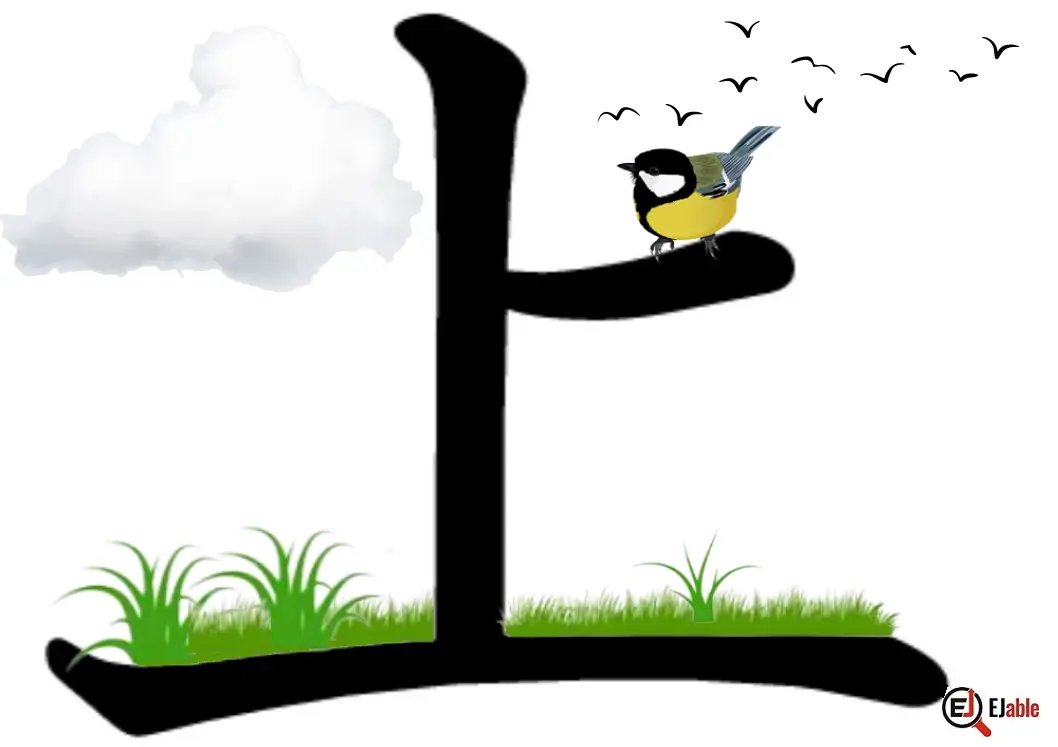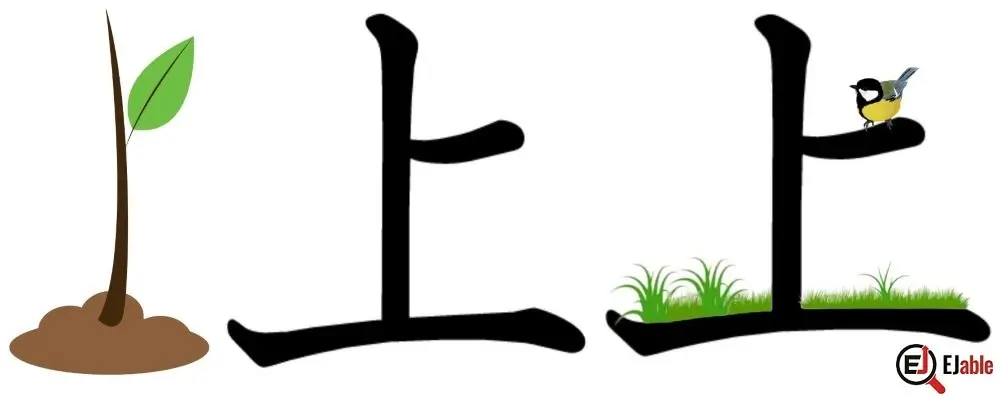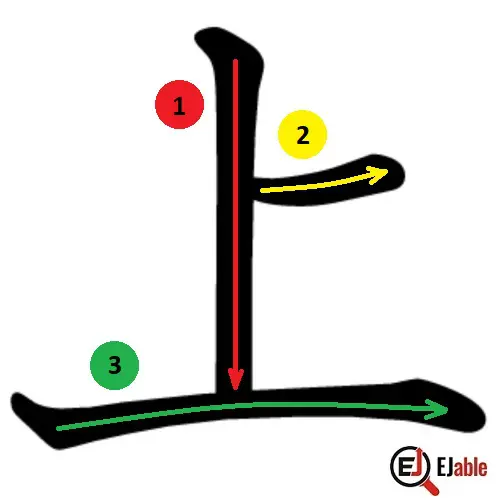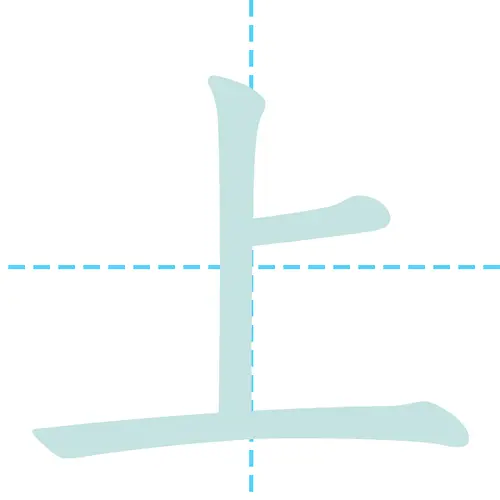Kanji for ‘Up’ or ‘Above’: 上

The Japanese Kanji for ‘Up’ or ‘Above’ is 上.
Various contexts for the usage of 上:
- Over: 上 refers to something over another thing in position.
- Top: The Kanji 上 is also used to describe something on top of others.
- Rise: 上 also means ascending or going up, as in 上る and 上り.
The kun’yomi (Japanese reading) pronunciations of the Kanji 上 are ‘nobu‘ (のぼ), as in words ‘noboru‘ (のぼる) and ‘noboseru‘ (のぼせる), ‘kami‘ (かみ), ‘uwa‘ (うわ), ‘ue‘ (うえ), ‘a‘ (あ) as in ‘a-geru’ (あ-げる), and a-garu (あ-がる). The on’yomi (Chinese reading) pronunciations of 上 are ‘jo‘ (ジョウ), and ‘sho‘ (ショウ).
The use of the Kanji 上 is very common in Japanese names, appearing in 11811 names. However, in names, it is pronounced as one of the following: ‘aoi‘ (あおい), ‘age‘ (あげ), ‘i‘ (い), ‘ka‘ (か), ‘kaki‘ (かき), ‘kazu‘ (かず), ‘kan‘ (かん), ‘kō‘ (こう), ‘nobori‘ (のぼり) or ‘hotsu‘ (ほつ).
The Kanji 上 is constructed with 3 strokes. It is part of the JLPT N5 syllabus (please check the list of JLPT N5 Kanji) and is taught in grade 1 in Japanese schools.
Origin of the Kanji 上
The origin of the Kanji was a very simple shape. The Oracle Bone Script showed a small dash above a bigger line, denoting something placed above the base. However, that simple shape was easy to confuse with the Kanji of number 2 (二). The Bronze inscription showed this Kanji as it appears today. However, there have been some more variations of the shape of this Kanji in the ancient scripts, as shown below:

Mnemonic to Remember the Kanji 上’s Meaning as ‘Above’ or ‘Up’
The Kanji 上, meaning up or above, is one of the simplest to remember. However, the following pictorial mnemonic will make it unforgettable:

Stroke Order of the Kanji 上
The following illustrations show the order of the 3 strokes to write the Kanji 上:


上 as a Component in other Kanji Characters
The Kanji 上 is used as a component in 25 Kanji characters, out of which the following 6 are Jōyō (commonly used) Kanji:
- 督 (トク / toku): Supervise, oversee
- Explanation: This kanji is used primarily in contexts involving supervision or oversight, suggesting someone in charge or overseeing a process.
- 叔 (シュク / shuku): Uncle
- Explanation: “叔” refers specifically to one’s younger uncle, indicating a familial relationship on the same generational level but younger than one’s parent. However, even the younger uncle is above you in status.
- 寂 (さび /sabi, セキ / seki, ジャク / jaku): Lonely, quiet
- Explanation: This character expresses the feeling of loneliness or the state of being quiet and deserted, often used in poetic or emotional contexts.
- 峠 (とうげ / toge): Mountain pass
- Explanation: Represents a geographic feature, specifically the highest point of a mountain road, combining elements that signify the surrounding landscape.
- 戚 (セキ / seki): Relative, kinship
- Explanation: This kanji is used to denote relatives or kinship, focusing on connections by blood or marriage.
- 淑 (シュク / shuku): Graceful, gentle, ladylike
- Explanation: “淑” characterizes a person, typically a woman, as graceful or possessing refined qualities. It is often used in descriptions that emphasize elegance or virtue.
Each of the above kanji integrates “上” to convey various aspects of supervision, familial relationships, emotional states, or personal qualities, demonstrating the character’s versatility in forming compound meanings directly or indirectly related to the concept of being above or higher importance.
上 Kanji in Compounded Words
There are 510 Japanese words that begin with the Kanji for up or above (上), and it appears in 1338 words overall.
Examples of Kanji 上 in Compounded Japanese Words
- 上腕 (じょうわん): upper arm
- 上映 (じょうえい): screening (of a movie)
- 上空 (じょうくう): sky, airspace
- 上京 (じょうきょう): going to the capital (Tokyo)
- 上位 (じょうい): upper rank, high position
- 上品 (じょうひん): elegant, refined
- 上演 (じょうえん): performance (of a play)
- 上限 (じょうげん): upper limit
- 上旬 (じょうじゅん): first ten days of the month
- 上回る (うわまわる): to exceed, to surpass
- 上司 (じょうし): boss, superior officer
- 上手 (じょうず): skillful, good at
- 上着 (うわぎ): jacket, outerwear
- 上下 (じょうげ): up and down, vertical
- 上線 (じょうせん): going online, becoming active
- 上述 (じょうじゅつ): aforementioned, as stated above
- 上場 (じょうじょう): listing (on a stock exchange)
- 上達 (じょうたつ): improvement, progress
- 上流 (じょうりゅう): upper class, upper stream
- 上陸 (じょうりく): landing, coming ashore
These examples illustrate how “上” is used to convey various aspects of superiority or higher up in position or sequence.
Note about Other Kanjis for Climbing or Going Up
We discussed that the Kanji 上 also means ascending or going up, as in ‘noboru‘ (のぼる) and ‘noboseru‘ (のぼせる). However, there are two other Kanji characters, which means ascending or climbing up. These are 昇, 登. Let’s check the differences in the context of the usage of 昇, 登, and 上る:
昇 (のぼる):
- Meaning: This term specifically refers to rising vertically, typically used for the sun (日の出) or a more figurative rise, such as a promotion (昇進).
- Usage: This kanji emphasizes a vertical ascent, especially in a non-physical, often symbolic or metaphorical context, like advancement in rank or status.
登 (のぼる):
- Meaning: Climbing, especially used for physical ascents like climbing mountains (登山) or stairs (階段を登る).
- Usage: This kanji is used primarily for physical climbing or scaling, and it connotes effort and exertion to achieve a higher place.
上る (のぼる):
- Meaning: A general term for going up, applicable to a wide variety of upward movements, from climbing mountains to ascending stairs or even prices going up (物価が上る).
- Usage: As a verb, のぼる is very versatile and can be used in almost any context involving upward movement, whether literal or figurative.
In summary:
- 昇 is more abstract, often used for rises in rank or status, and less commonly for physical ascension.
- 登 is specifically used for physical efforts of climbing, like mountains or other steep ascents.
- 上る is the most general and can be used interchangeably in many contexts where something is going upward, covering both literal and metaphorical uses.
Note: Check other Kanji characters on the page “How to Learn Kanji“and the guide to Kanji radicals.

A long-term ex-pat in Japan, Himanshu comes with an IT background in SAP consulting, IT Business Development, and then running the country operations of an IT consulting multinational. Himanshu is the co-founder and Managing Director of ReachExt K.K. and EJable.com. He is also an Advisory Board Member of a Silicon Valley AI/IoT startup.
